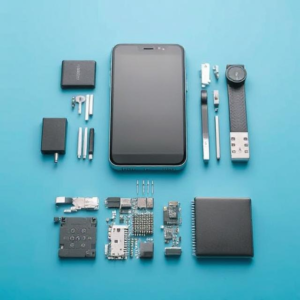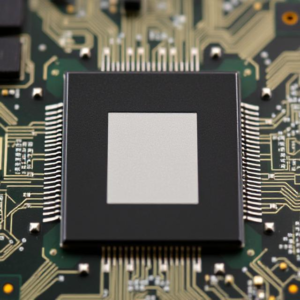1. What is a Smartphone?
A smartphone is a portable electronic device that combines a phone, computer, and many other features into one. It lets you make calls, send messages, browse the internet, take pictures, and run apps. Inside a smartphone, there are many hardware components that work together to make all these functions possible.

2. Smartphone Hardware: The Physical Components
The hardware refers to all the physical parts inside a smartphone that you can touch and see. Let’s look at the main hardware components:
A. Processor (CPU)
- The processor (also called the central processing unit, or CPU) is the brain of the smartphone. It handles all the calculations and makes sure everything runs smoothly.
- It executes instructions, runs apps, and processes data. The faster the processor, the better the smartphone’s performance.
- Example: Qualcomm Snapdragon and Apple A-series chips are popular processors in smartphones.
B. Memory (RAM and Storage)
- RAM (Random Access Memory) is like a short-term memory for your phone. It helps the phone quickly access data and run apps smoothly. More RAM means your phone can handle more tasks at once without slowing down.
- Storage is like the long-term memory. It’s where you store your photos, apps, music, and files. You can get more storage by using an SD card or choosing a phone with more built-in storage.
- Example: Most smartphones have 4GB, 8GB, or more RAM, and internal storage can range from 64GB to 512GB or more.
C. Battery
- The battery powers the phone. It stores energy and provides the phone with the power it needs to run. Modern smartphones use lithium-ion batteries, which are rechargeable and last for many hours.
- The battery life depends on how powerful the phone is, how much you use it, and how efficient the system is at saving energy.
D. Display
- The display is the screen you touch to interact with the phone. Most smartphones today have LCD or OLED displays.
- The display shows images, videos, and text. The quality of the display (like HD or 4K) affects how clear and vibrant the content looks.
- Touchscreen displays let you interact with your phone by tapping, swiping, and scrolling.
E. Camera
- The camera is one of the most important features for many smartphone users. Most smartphones today have high-quality front (selfie) and rear (main) cameras.
- Cameras use lenses and image sensors to capture photos and videos. The camera hardware includes features like autofocus, flash, and optical zoom.
- Smartphones use software (the phone’s operating system) along with hardware to improve photos, such as through software-based image processing (making pictures clearer or adding effects).
F. Sensors
- Smartphones are packed with sensors that help the phone interact with the world around it. These sensors include:
- Accelerometer: Detects the phone’s orientation and movement (e.g., to know if the phone is being tilted or shaken).
- Gyroscope: Measures the rotation of the phone, useful for things like screen orientation.
- GPS: Helps locate your position on a map.
- Proximity Sensor: Detects how close the phone is to your face (e.g., to turn off the screen when you’re on a call).
- Fingerprint sensor: Used for security (unlocking the phone with your fingerprint).
G. Connectivity (Wi-Fi, Bluetooth, etc.)
- Wi-Fi and Bluetooth are essential for connecting your smartphone to the internet and other devices. Wi-Fi connects your phone to the internet via routers, while Bluetooth lets your phone connect to other devices (like wireless headphones).
- Smartphones also support cellular connectivity (like 4G or 5G) for making calls and using the internet on the go.
3. Smartphone System Design: The Software and Architecture
While hardware is about the physical parts, system design focuses on the software (the programs that run on the smartphone) and how all the hardware components work together. This includes the operating system, app management, and how everything is organized inside the phone.
A. Operating System (OS)
The operating system is the software that controls everything on the phone. It acts like a manager, making sure hardware and apps work together.
- The most common smartphone operating systems are:
- Android (developed by Google)
- iOS (developed by Apple)
- The OS handles things like user interface (how you interact with the phone), memory management (how apps and data are handled), and security (protecting your data).
B. Software and Apps
- Apps are programs that allow you to do specific tasks, like checking your email, playing games, or taking photos. Smartphones come with pre-installed apps (like a camera app or a browser), but you can also download thousands of other apps from stores like the Google Play Store (for Android) or the App Store (for iOS).
- The system design ensures that apps run smoothly and can interact with the hardware components like the camera, sensors, and processor.
C. User Interface (UI) and User Experience (UX)
- UI (User Interface) is how the phone looks and feels. It’s everything you see on the screen, like the icons, buttons, and menus.
- UX (User Experience) is how easy and pleasant the phone is to use. Good UX design means everything is intuitive and easy to navigate. This involves how you interact with apps, how responsive the touchscreen is, and how simple it is to switch between tasks.
D. Power Management and Optimization
- Power management is crucial for extending the battery life. The operating system and system design work together to make sure the phone uses power efficiently. For example, when you’re not using the phone, the OS can put it into a low-power mode to save battery.
- Optimization is about ensuring that all the hardware works together smoothly without slowing down the phone.
4. How All the Components Work Together
Let’s say you open an app like your camera app:
- The processor (CPU) gets the request to open the camera.
- It sends commands to the camera hardware (the image sensor and lens).
- The operating system (OS) makes sure the camera app is running and allows you to interact with it.
- The display shows the live feed from the camera.
- You take a picture, and the image is processed using the camera’s sensors and the phone’s software.
- The picture gets saved to the storage and can be shared with other apps or sent via Wi-Fi or Bluetooth.
5. In Summary:
- Smartphone hardware includes the physical components (processor, memory, battery, camera, display, sensors, etc.) that make the phone function.
- System design is the software (like the operating system and apps) that manages how all these hardware components work together.
- Together, the hardware and system design allow your phone to perform tasks like making calls, running apps, capturing photos, and connecting to the internet.











